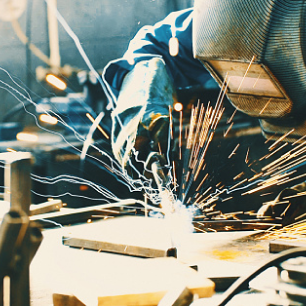Jump to:
The Answer Is
Q: Maybe you can help me with a problem we are having on our production floor. We are using an oxyacetylene torch to preheat the steel before welding. The torch is popping and hissing and making everyone uncomfortable. What’s going on?
A: I think I can help you based on what you described. The torch is starving for fuel, i.e., acetylene.
Acetylene is not stable at pressures above 15 lb/in.2. The good folks who refill the acetylene cylinders are well aware of the problem, so they take steps to stabilize the gas. The acetylene cylinder is not just an empty tank pumped full of gas. The cylinder is filled with a porous material, so the acetylene molecules are separated within the pores of the media. In addition, the acetylene gas is dissolved in acetone, much like carbon dioxide is dissolved in the water in a bottle of seltzer. These precautions stabilize the acetylene while it is pressurized in the cylinder.
Now, to your problem: The acetylene must come out of the solution; that is, the acetylene must separate from the acetone before being conducted to the pressure-reducing regulator and then to the hose supplying the torch. If there is an attempt to withdraw too much acetylene from the cylinder, the gas doesn’t have time to separate from the acetone, and both the acetylene and acetone come out of the cylinder. You see the same thing if one suddenly pops the cap off a bottle of seltzer. Both the water and carbon dioxide gush out as foam. So, to prevent the seltzer from foaming, the cap is removed slowly to limit the volume of carbon dioxide escapes. The withdrawal rate of the acetylene has to be slow enough to ensure the acetylene has sufficient time to separate from the acetone. The goal is for only the acetylene to be delivered to the pressure-reducing regulator. The idea is to leave the acetone in the cylinder.
When it is first lit, the torch operates as intended, but as the acetylene is depleted, the volume of acetylene remaining in the cylinder diminishes, and the volume of acetylene that can safely be provided is reduced. After a short while, “pop, bang, hiss,” the flame goes out with a pop. What do we do? What’s happening?
Normally, the combustion of the oxygen and acetylene occurs at the torch tip, just beyond the end of the heating tip. With the drop in acetylene pressure, combustion can occur inside the heating tip. When using a large heating tip, the demand for fuel gas may easily outstrip the ability of the cylinder to deliver the quantity of acetylene required. As a result, the delivery pressure drops, and acetylene and acetone are pulled from the cylinder, as well as acetylene. One will see sparks in the torch’s flame, and it will start to “pop” or backfire. In a worst-case scenario, the combustion can take place inside the torch handle, melting the torch and burning the operator’s hand. The telltale hissing and black smoke are indications that the torch is about to self-destruct.
One solution is to use an alternative fuel gas, i.e., liquefied petroleum gas, MAPP gas, etc. Another solution is to use a larger acetylene cylinder or connect a couple of acetylene cylinders to increase the volume of acetylene available for delivery to the acetylene regulator.
Occupational Safety and Health Administration (OSHA) 29CFR 1910.102, 1910.102(a), 1910.253, and CGA G-1-2009 are the standards where one will find the rules established by OSHA for the safe delivery of acetylene. CGA G-1 states a withdrawal rate of 1/7 of the cylinder’s content is generally safe. However, it states, “to minimize the withdrawal of liquid solvent in applications that are more sensitive to solvent carry-over, acetylene should be withdrawn from the cylinder at a rate not to exceed 1/10 the capacity of the cylinder per hour during intermittent use.” For a permanent installation (think burning tables), the maximum withdrawal rate is 1/15 the acetylene cylinder volume or cylinders connected using a manifold.
Let’s look at how this works.
Volume of heat required — 140,000 BTU/hr (the bigger the torch tip, the greater the volume of acetylene needed)
Volume of the acetylene cylinder — 350 ft3 (when full)
Volume of acetylene required — 87 ft3/h
Portable/Intermittent use of 350 ft3 × 10% = 35 ft3/h (three 350 ft3 cylinders connected to a manifold would safely supply 105 ft3/h of acetylene to the torch when first lit)
The weight of acetylene remaining in the cylinder diminishes over time. Thus, it seems reasonable that as the cylinder nears depletion, it may not be able to deliver the volume of fuel needed to maintain the proper operating pressure.
While one can withdraw more acetylene than the quantity permitted by CGA G-1 (based on the volume of the cylinder), remember as the withdrawal rate increases, the probability acetone will be pulled from the cylinder increases because the acetylene and acetone cannot properly separate. Acetone does nothing beneficial to the regulator or hoses!
The bottom line is that it sounds like you need to provide a sufficient volume of acetylene gas to the torch based on the size of the heating tip you are using. Here are a couple of suggestions:
1) Use a larger cylinder of acetylene,
2) Use multiple cylinders of acetylene connected with a manifold, or
3) Switch to LP gas or another alternative to acetylene. This would require a different pressure-reducing regulator for the fuel gas and a different style of heating tip (must be compatible with LP fuel).
Be aware that if you switch to LP fuel, very cold winter days can present a problem. It takes heat to cause the liquefied petroleum gas to change from a liquid to a gas. If the LP tanks are inside a heated shop, it should not be a problem. However, if the work is outside in the weather, those cold winter days may prevent enough gas to boil off to properly supply the heating torch. You won’t get a satisfactory flame.
I hope I have explained the problem sufficiently to satisfy your curiosity and offered some solutions to cure the problem.
Any article on using and handling gases contained in high-pressure cylinders deserves a few words on safety. Once again, OSHA and CGA provide some direction on the safe handling of gas cylinders. Let’s review a few safety rules that come to mind. Keep in mind, this list is not all inclusive:
Gas cylinders are to be transported, stored, and used while in the vertical upright position.
Gas cylinders are to be secured using a metal chain. Nonmetallic straps should not be used to secure gas cylinders.
High-pressure cylinders, other than fuel gases, are supposed to be opened all the way to ensure the double-seated valve reseats in the open position to prevent leakage around the valve stem.
Fuel gas cylinders should be opened only about ½ turns to allow them to be closed quickly when necessary.
Acetylene should never be used at a pressure greater than 15 lb/in.2.
Valves must be closed completely when the torch is not being used, or the cylinder is empty.
Relieve the pressure on the diaphragm by backing the pressure adjustment screw of the pressure-reducing regulator out when the torch is not in use.
Crack the cylinder valve to clear it of dust and debris before closing it and attaching the pressure-reducing regulation.
Fuel gases are supposed to be stored separately from other gases except when secured in a cart and in use.
Secure all cylinders from egress paths or pathways used by forklifts and other material handling equipment. Do not allow anything to run over the hoses.
Never lift gas cylinders by their caps. The holes or slots are not intended to be used for lifting the cylinder.
Use a cart to move cylinders from one location to another.
Do not use magnetic lifting devices for lifting or moving gas cylinders.
Never use a gas cylinder as a roller.
Never throw a cylinder or slam them down when handling the gas cylinder.
Never allow the gas cylinder to become part of the electrical circuit or come in contact with live currents. Arc strikes against the cylinder wall can lead to catastrophic outcomes.
Never apply lubricants to the threads on the cylinder valve or the pressure-reducing regulator.
Do not light the torch with anything other than a spark lighter.
Do not use oxygen as a substitute for compressed air.
The Society is not responsible for any statements made or opinions expressed herein. Data and information developed by the authors are for specific informational purposes only and are not intended for use without independent, substantiating investigation on the part of potential users.
ALBERT J. MOORE JR. (amoore999@comcast.net) is president and owner of NAVSEA Solutions/Marion Testing & Inspection, Burlington, Conn. He is an AWS Senior Certified Welding Inspector and an ASNT NDT Level III. He is also a member of the AWS Qualification & Certification Committee on Methods of Inspection.


